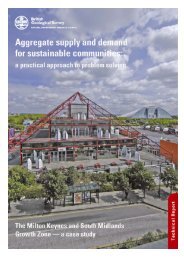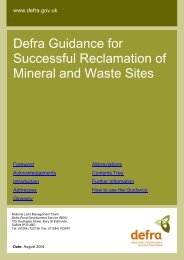creating environmental improvements through biodiversity
creating environmental improvements through biodiversity
creating environmental improvements through biodiversity
Create successful ePaper yourself
Turn your PDF publications into a flip-book with our unique Google optimized e-Paper software.
• Archaeology in the area has produced a wealth of <strong>environmental</strong> data, which indicates that:<br />
• There were early partially cleared islands (partially cleared of woodland) as part of a ritual landscape<br />
• These were used and expanded in the Bronze Age<br />
• The floodplain and lower slopes were almost totally cleared in the Iron Age<br />
• An intensive arable-based landscape existed in the Iron Age, including farms, roads and fields<br />
• The Iron Age landscape was re-modelled in the Roman period, including creation of a vineyard<br />
• Intense land use continued in the post Roman-Saxon period, with modern boundaries and features<br />
emerging<br />
• There is probably no other valley in England where the landscape story is as well known as a result of<br />
aggregate extraction<br />
• Future extraction must facilitate further contextualisation and synthesis of <strong>environmental</strong> data on a site<br />
by site basis<br />
• This will be aided by the augmentation of the GIS system developed as part of this project and held by<br />
Northamptonshire County Council<br />
Impacts (Actual / Potential):<br />
While the study may be largely of archaeological interest, the history of the landscape that emerges from<br />
it provides a useful context against which to assess any minerals site restoration proposals. This is highly<br />
relevant as a large number of minerals sites exist in the valley, and the minerals resource there is now<br />
diminishing.<br />
While it may not be appropriate to restore to the ‘original’ forested landscape of pre-Bronze Age, features<br />
of the later, more modified landscape, such as hedgerows, may be relevant to restorations. Findings on the<br />
river’s original structure may likewise provide guidance on restoration techniques. The river was probably<br />
originally of a dynamic braided structure, with little continuous deep water, periodic flooding, some islands of<br />
drier gravel, and some shallow open water. Restoration to a similar structure would provide valuable habitat<br />
for a range of species, and be in keeping with the ‘natural’ state of the valley. While it would be impractical to<br />
restore the river entirely to this structure due to navigation needs, it may be possible to simulate it in some<br />
areas of the valley.<br />
Potential Expansion:<br />
Further archaeological study of the area is needed to fill in the gaps in knowledge identified in this<br />
project. As stated in the report, ‘future extraction must facilitate further contextualisation and synthesis<br />
of <strong>environmental</strong> data on a site by site basis. This will be aided by the augmentation of the GIS system<br />
developed as part of this project and held by Northamptonshire County Council.’<br />
Dissemination:<br />
Information on dissemination of this report could not be obtained.<br />
Sustainable Aggregates Creating Environmental Improvements <strong>through</strong> Biodiversity<br />
THE POTENTIAL CONTRIBUTION OF THE MINERAL EXTRACTION<br />
INDUSTRIES TO THE UK BIODIVERSITY ACTION PLAN (ENGLISH NATURE,<br />
QUARRY PRODUCTS ASSOCIATION, SILICA AND MOULDING SANDS<br />
ASSOCIATION – ENGLISH NATURE RESEARCH REPORT NO. 279)<br />
Richard Bate, Jennifer Bate (Green Balance), Christine Bradley, Hannah Peel, Janet Wilkinson (Applied<br />
Environmental Research Centre Ltd.) 1998<br />
Project Type: Guidance for the minerals industry and English Nature on Biodiversity Action Plans (BAPs)<br />
51

















